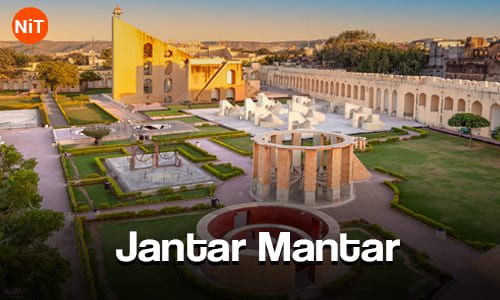Jantar Mantar, Jaipur

Jantar Mantar in Jaipur is an amazing place that shows the intelligence of ancient Indian science and architecture. There are 19 tools used to study the stars and sky. One of them is the Samrat Yantra, the world's largest sundial in Jaipur that tells time according to the sun's position.
This Samrat Yantra, 27 meters tall, is a main reason that brings visitors from all over the world. It shows the advanced knowledge and skills of earlier times, making it a top place for those interested in history and science. This Jantar Mantar tour guide will give you all the important information you need about the place.
Quick Information
| Location | Jantar Mantar, Jaipur, Rajasthan |
| Type | Historical Observatory |
| Opening Time | 9 AM to 5 PM |
| Entry Fee | 50 Indian, 200 Foreigners |
| Nearest Metro Station | Jaipur Junction (3 km away) |
| Photography Charges | No additional charges for photography |
| Best time to visit | October to March (cool weather) |
| Nearby Places to explore | Hawa Mahal, City Palace, Amber Fort and Nahargarh Fort |
| Time Required | Around 2 to 3 hours |
| Dress Code | Casual and comfortable clothes |
| Architecture | The architecture combines scientific design with artistic beauty, this place has big stone tools used to study the stars and tell time. |
History
Construction by Raja Jai Singh- Jantar Mantar in Jaipur was built by Raja Jai Singh II, between 1728 to 1734. Jai Singh was interested in astronomy. He created this observatory to study the stars and planets. He built observations in other cities, but the one in Jaipur is the biggest and most popular.
Peak Activity in 1735- In 1735, when the building was almost finished, around 23 astronomers worked at Jantar Mantar. At this time, Raja Jai Singh made Jaipur the main place for his observatory instead of Delhi.
Decline after Jai Singh’s Death- When Raja Jai Singh passed away in 1743, the observatory received less support. After him, Isvari Singh became king but he didn’t pay much attention to the observatory due to political changes.
Renovation by Ram Singh- In 1876, King Ram Singh tried to fix the observatory. He strengthened some of the instruments with stone and repaired others made of plaster. Even though there were efforts to restore it, the observatory was neglected once more, but it still holds great value in history.
Architecture
Incredible Design- Jantar Mantar in Jaipur is where scientific ideas and impressive structures come together. It has stone-made instruments for studying the stars and measuring time.
Open-Air Instruments- The instruments were built outside without roofs so astronomers can observe the sky directly.
Size and Beauty- The instruments are large and look impressive combining both science and art.
Well-Designed Structure- The instruments at Jantar Mantar were made to work well together. This shows how ancient science and architecture were accurate even without modern tools.
What to See at Jantar Mantar ?
There are many fascinating instruments at Jantar Mantar of Jaipur. Here are the most important ones to explore-
Ram Yantra- The Ram Yantra is an instrument used to measure the altitude (height) and azimuth (direction) of the Sun and planets. Each structure has a pole of equal height in the middle. The Ram Yantra is found only in Jantar Mantar of Jaipur and New Delhi.
Nadivalaya- The Nadivalaya has two circular plates facing north and south, They show both sides of the Earth.
Laghu Samrat Yantra- It works like the larger Samrat Yantra but is smaller in size. It can tell time accurately, within twenty seconds. The slope of the Yantra points towards the North Pole, and by looking at the shadow, this Yantra can tell the current time in Jaipur.
Chakra Yantra- The Chakra Yantra uses four curved parts where a shadow indicates the Sun's position at four specific times during the day.
Things to Do
Take a guided Tour- You can take a guided tour to understand the meaning of each instrument better. A guide will explain how each device works and its history, helping you learn more about ancient Indian science and architecture.
Enjoy the Calm Atmosphere- Visitors can enjoy a peaceful environment at Jantar Mantar with family or friends. It is also a great spot for a picnic. The open area with its beautiful surroundings gives a unique experience.
Attend Exhibition Events- At Jantar Mantar you can attend special events or exhibitions that give you a better understanding of astronomy and the observatory’s history.
Explore the Nearby Places- Combine your trip to Jantar Mantar with a visit to nearby historical spots such as the City Palace or Hawa Mahal, to learn more about Jaipur’s history.
Best Time to Visit
Jantar Mantar stays open for tourists all year round, best months are between October to March.
- Best Day of the Week - Plan your trip to Jantar on weekdays to avoid weekend crowds.
- Best Time of the Day- Visit Jantar Mantar in the early morning that lets you avoid crowds and take your time exploring.
How to Reach
| Jantar Mantar, Jaipur | Transportation Details |
|---|---|
| By Plane | Jantar Mantar is around 12 kilometers from Jaipur International Airport (Sanganer Airport). You can get to Jantar Mantar in 25-30 minutes by taxi, auto-rickshaw or cab. |
| By Train | Jaipur railway station to Jantar Mantar distance is around 3 kilometers. You can reach Jantar Mantar in about 10-15 minutes by car or auto-rickshaw from the station. The name of Jaipur's railway station is Jaipur Junction. |
| By Bus | The nearest bus stop to Jantar Mantar is Tripolia Bazar, just 500 meters away. It's an 8-minute walk or a short rickshaw ride. |



 Call
Call WhatsApp
WhatsApp Enquiry
Enquiry